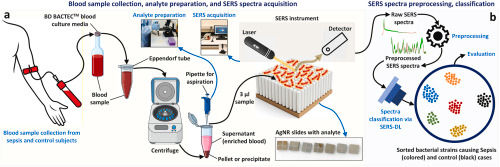Examining a different aspect in SERS measurement: the analyte size effect
- Yiping Zhao
- Apr 1, 2024
- 2 min read
In a recent study, we investigated a crucial aspect of surface-enhanced Raman spectroscopy (SERS) detection: the effect of analyte size. In the SERS community, it's widely recognized that signal enhancement occurs in tiny gaps (< 10 nm) between plasmonic nanoparticles when they resonate, creating intense local electric fields known as "hotspots." However, this enhancement is only effective when the target analyte molecule is located within or near these hotspots. When the analyte is much larger than the hotspot, such as with large biomolecules, viruses, or bacteria, it cannot access the hotspot due to size exclusion. Thus, understanding how analyte size affects SERS enhancement and detection conditions is crucial, and this forms the focus of our study.
Our research unveils several important findings. Firstly, we pinpoint the "effective hotspot" for detecting larger particles as the area where these particles adhere most strongly to the metal surface, where the electric field is strongest. Interestingly, we observe that particle size significantly influences the location of this effective hotspot and its resonance frequency. This dependency on particle size highlights the complexity of SERS detection in the presence of larger particles. Additionally, our study reveals changes in the behavior of the distance-dependent enhancement factor for SERS when larger particles are present. This suggests that components within the particle itself can significantly contribute to the observed SERS spectra, adding another layer of complexity to the detection process.
Overall, our findings emphasize the need for a nuanced approach when designing SERS substrates for detecting large-sized particles, especially in biological or particulate samples. We stress the importance of considering different design principles and factors compared to traditional SERS setups targeting smaller particles. By doing so, our research offers valuable insights for improving detection sensitivity and accuracy in biological analyses using SERS techniques.
The full article can be found at The impact of analyte size on SERS enhancement location, enhancement factor, excitation wavelength, and spectrum - Sensors & Diagnostics (RSC Publishing) DOI:10.1039/D4SD00014E.






Comments